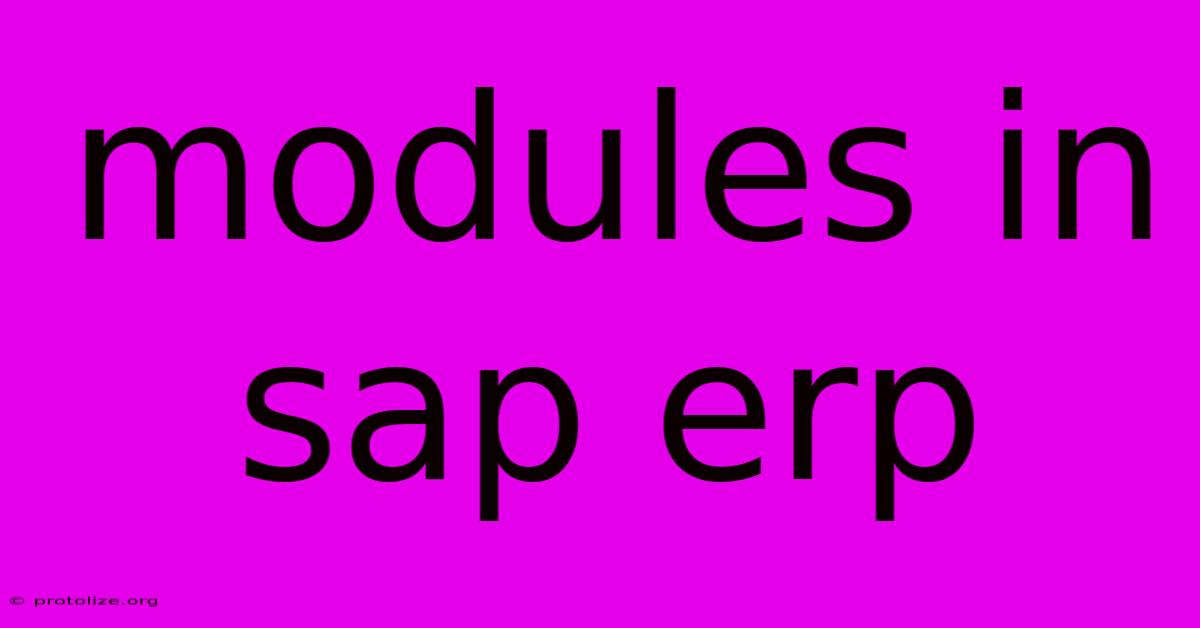Modules In Sap Erp

Discover more detailed and exciting information on our website. Click the link below to start your adventure: Visit Best Website mr.cleine.com. Don't miss out!
Table of Contents
Understanding SAP ERP Modules: A Comprehensive Guide
SAP ERP (Enterprise Resource Planning) is a powerful suite of integrated software applications designed to manage and streamline business operations. It's not a single monolithic system, but rather a collection of interconnected modules, each focusing on a specific area of business functionality. Understanding these modules is crucial for effectively leveraging the power of SAP ERP. This guide provides a comprehensive overview of key SAP ERP modules, their functionalities, and how they interact.
Core SAP ERP Modules: The Foundation of Your Business
Several modules form the core of any SAP ERP implementation. These are essential for managing fundamental business processes and often serve as the basis for integrating other, more specialized modules.
1. Financial Accounting (FI): The Heart of Financial Management
The FI module is the cornerstone of SAP ERP's financial management capabilities. It handles all aspects of financial accounting, including:
- General Ledger (G/L): Tracks all financial transactions, providing a complete picture of the company's financial position.
- Accounts Receivable (A/R): Manages customer invoices, payments, and outstanding balances.
- Accounts Payable (A/P): Handles vendor invoices, payments, and outstanding liabilities.
- Asset Accounting (AA): Tracks the acquisition, depreciation, and disposal of fixed assets.
Key Benefits: Improved financial reporting accuracy, enhanced control over financial processes, and streamlined financial close cycles.
2. Management Accounting (CO): Gaining Managerial Insights
The CO module provides crucial management accounting functionalities, offering insights for strategic decision-making. Key features include:
- Cost Center Accounting: Tracks costs associated with specific organizational units.
- Profit Center Accounting: Measures the profitability of individual business units or departments.
- Internal Orders: Monitors costs associated with specific projects.
- Activity-Based Costing (ABC): Assigns costs based on the consumption of resources.
Key Benefits: Better cost control, improved profitability analysis, and more effective resource allocation.
3. Materials Management (MM): Optimizing Your Supply Chain
The MM module is central to managing the procurement and inventory of materials. Key functionalities include:
- Purchasing: Managing the entire procurement process from requisition to payment.
- Inventory Management: Tracking inventory levels, managing stock movements, and optimizing stock replenishment.
- Vendor Master Data: Maintaining information about suppliers.
- Material Master Data: Maintaining information about materials.
Key Benefits: Reduced inventory costs, improved supplier relationships, and optimized procurement processes.
Essential SAP ERP Modules: Expanding Your Capabilities
Beyond the core modules, several other modules are crucial for specific business functions, extending the capabilities of SAP ERP significantly.
4. Sales and Distribution (SD): Managing the Sales Cycle
The SD module manages the entire sales process, from order entry to delivery and billing. Key features include:
- Order Management: Managing customer orders, pricing, and availability.
- Delivery Processing: Managing the physical delivery of goods.
- Billing: Generating customer invoices and managing payments.
Key Benefits: Streamlined sales processes, improved order fulfillment, and enhanced customer satisfaction.
5. Production Planning (PP): Optimizing Manufacturing Processes
The PP module assists in planning and controlling manufacturing processes. Key functionalities include:
- Material Requirements Planning (MRP): Determining the required materials and resources for production.
- Capacity Planning: Ensuring sufficient capacity to meet production demands.
- Production Scheduling: Scheduling production runs and optimizing resource utilization.
Key Benefits: Optimized production schedules, reduced production costs, and improved on-time delivery.
6. Human Capital Management (HCM): Managing Your Workforce
The HCM module, formerly known as HR, manages all aspects of human resources. This includes:
- Payroll: Processing employee paychecks.
- Recruitment: Managing the recruitment and hiring process.
- Talent Management: Developing and managing employee skills and performance.
Key Benefits: Streamlined HR processes, improved employee management, and enhanced compliance.
Integrating SAP ERP Modules for Holistic Business Management
The power of SAP ERP lies in the seamless integration of its various modules. Data flows freely between modules, providing a holistic view of the business. For instance, data from the SD module (sales orders) automatically updates inventory levels in the MM module, triggering procurement processes in the purchasing area. This integrated approach eliminates data silos and streamlines operations across the entire organization.
This comprehensive overview highlights the key SAP ERP modules and their functionalities. A thorough understanding of these modules is crucial for effectively implementing and utilizing SAP ERP to maximize its benefits for your organization. Remember, the specific modules implemented will vary depending on the size and industry of the business. Consulting with SAP experts is highly recommended to determine the optimal configuration for your unique needs.

Thank you for visiting our website wich cover about Modules In Sap Erp. We hope the information provided has been useful to you. Feel free to contact us if you have any questions or need further assistance. See you next time and dont miss to bookmark.
Featured Posts
-
Erp Solutions Kanpur
Dec 13, 2024
-
Qpr Vs Oxford United Match Preview
Dec 13, 2024
-
Nen 2024 November 12th Update
Dec 13, 2024
-
Understanding Estrie Schools Budget Surplus
Dec 13, 2024
-
Goa Lifeguards Rescue Five Russians
Dec 13, 2024
